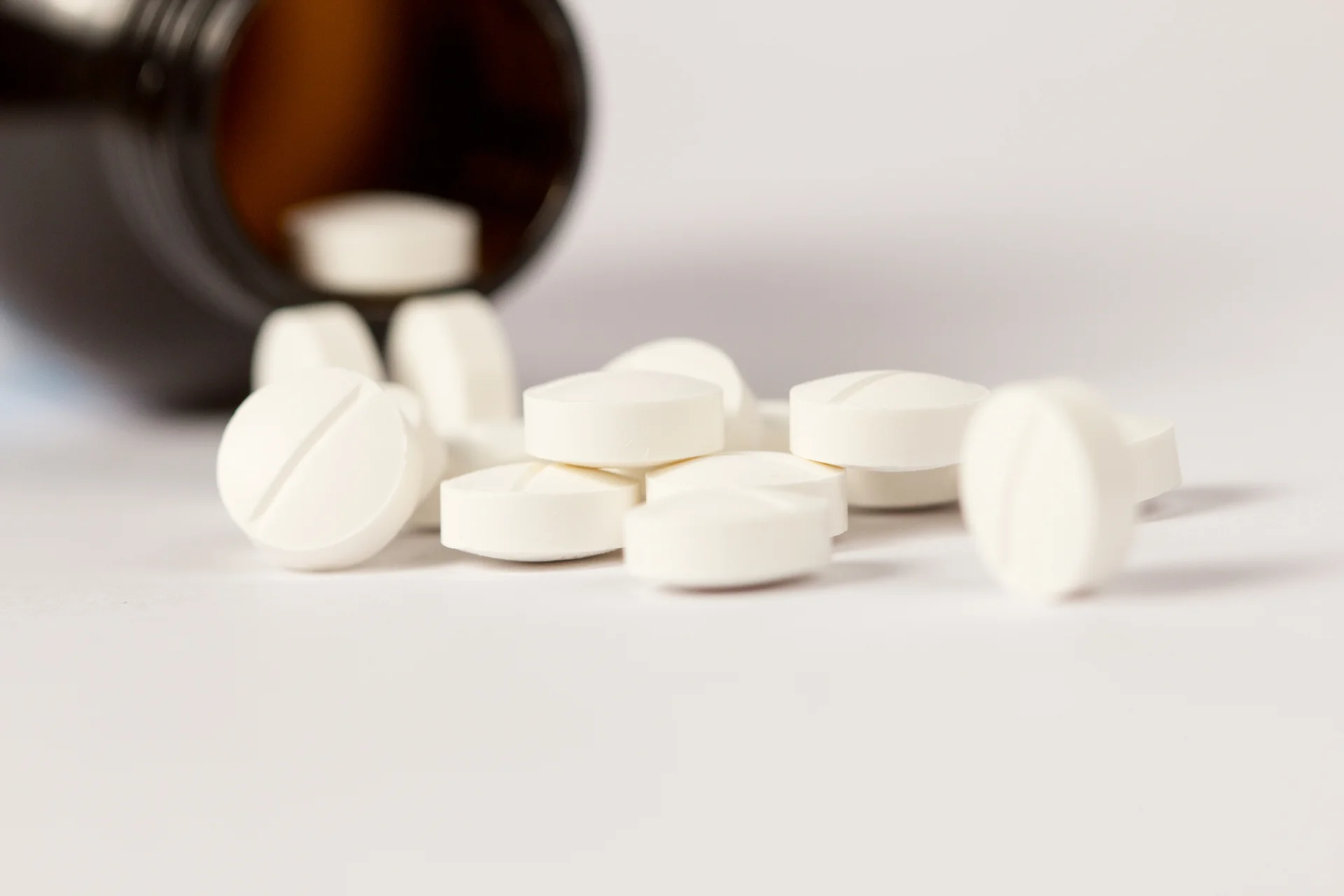Is meloxicam the secret to banishing your back pain for good or a recipe for disaster? Educate yourself before you medicate.
When over-the-counter meds fail, prescription NSAIDs almost always become the next option. Wondering if meloxicam could help? The short answer is yes. The drug has a fairly controversial reputation for treating back pain, though.
This guide by Kaly examines the risks and benefits of using meloxicam for back pain. Let’s weigh the latest evidence on the NSAID’s benefits versus bleeding risks to make the best choice for your health.
Concerned about meloxicam? Kaly connects you to orthopedic surgeons offering better solutions for your back pain.
Is Meloxicam Recommended for Back Pain?

Meloxicam may provide temporary relief for acute flare-ups of back pain but lacks FDA approval specifically for this use. Due to risks like bleeding and interactions, meloxicam is not recommended as a first option.
Safer alternatives and exploring other treatments for chronic back pain are advised instead of relying on meloxicam long-term.
What is Meloxicam?
Meloxicam is a non-steroidal anti-inflammatory drug (NSAID) often used for treating arthritis symptoms. It works by reducing inflammation that can cause pain.
Some key facts on meloxicam:
- Used to treat pain and inflammation from arthritis
- Available as oral tablets or intravenous injections
- Sold under brand names like Mobic and Vivlodex
Has Meloxicam Been Studied for Back Pain?
According to Kaly specialists, meloxicam has been researched in clinical trials for relieving back pain:
- Intravenous meloxicam significantly reduced pain after surgery based on studies.
- Oral meloxicam provided relief for acute flare-ups of non-specific back pain in trials, especially for younger adults and those with their first episode of back pain.
- However, meloxicam does not have FDA approval specifically for treating general back pain – only for arthritis symptoms.
What is the Typical Meloxicam Dosage for Back Pain?
The usual dose of meloxicam for back pain is 7.5 mg taken orally once per day for adults initially. It takes 2-3 weeks for meloxicam to start working and months to reach full effect, so it should not be viewed as a quick fix.
According to Kaly specialists, meloxicam does not have an FDA-approved dosing regimen specifically for back pain treatment.
For children ages 60+ kg with juvenile rheumatoid arthritis, the standard oral dose is also 7.5 mg once daily. But Kaly specialists do not recommend meloxicam for back pain in children, as there is very limited safety data.
Kaly experts emphasize working closely with your doctor to determine the appropriate meloxicam dosage regimen based on your individual back pain symptoms and health profile. The lowest effective dose should always be the goal.
Can Meloxicam 15 mg Be Used for Lower Back Pain?
Meloxicam 15mg daily can be used short-term for acute lower back pain flare-ups, as studies show it provides effective pain relief. However, meloxicam 15mg also has risks with long-term use. Meloxicam is not a cure for chronic lower back pain.
- A 2018 clinical trial found that periradicular injections of meloxicam significantly reduced lower back pain compared to placebo injections.
- A 2015 observational study found that oral meloxicam 15mg daily effectively treated acute non-specific lower back pain.
Overall, research suggests 15mg daily meloxicam may deliver effective short-term relief for acute flare-ups of lower back pain when used under medical supervision.
What are the Possible Side Effects of Using Meloxicam?
Common short-term side effects of meloxicam for back pain include stomach upset, headaches, dizziness, and skin rashes. More serious side effects needing medical attention include allergic reactions, heart attack, stroke, and stomach bleeding.
With extended daily usage, risks of cardiovascular damage, gastrointestinal injury, liver toxicity, and kidney impairment may arise. Kaly experts advise reporting any concerning symptoms to your healthcare provider promptly.
Is Celebrex or Meloxicam Better for Treating Back Pain?
For back pain treatment, celecoxib may offer faster relief while meloxicam is also effective for pain and inflammation. Both celecoxib and meloxicam carry risks like gastrointestinal bleeding and cardiovascular events.
Celecoxib costs more but has additional approved uses over meloxicam. The following comparison table gives a good overview of the differences between the two medications:
| Feature | Celecoxib (Celebrex) | Meloxicam |
| Effectiveness | May provide faster relief. More effective than acetaminophen for chronic back pain in one study | Effective at reducing inflammation and pain |
| FDA Approvals | Approved for more conditions including acute pain and dysmenorrhea | Only approved for arthritis symptoms |
| Side Effects | Can cause GI bleeding/ulcers, but may be lower risk than traditional NSAIDs. More associated with abdominal discomfort | Can cause GI bleeding/ulcers. More associated with drowsiness |
| Cardiovascular Risks | Associated with increased risk of heart attack and stroke | Also carries risks of heart attack and stroke |
| Cost | Tends to be more expensive | Typically less expensive |
How Does Meloxicam Compare with Ibuprofen for Back Pain?

For back pain relief, meloxicam and ibuprofen have close to equal effectiveness. However, meloxicam may work better for more severe pain given its higher potency.
While both can cause gastrointestinal side effects, meloxicam has a higher bleeding risk, and ibuprofen has fewer cardiovascular risks. Despite comparable efficacy for back pain, their administration frequency and side effect profiles differ.
However, some evidence indicates that meloxicam may provide better relief for more severe back pain, given its higher potency as an NSAID. But for mild to moderate back pain, studies suggest their effectiveness is comparable.
Key Differences in Administration and Side Effects
- Dosage: Ibuprofen is typically taken every 4-6 hours as needed, at OTC doses of 200-400 mg per dose. Meloxicam is taken just once daily, usually at a dose of 7.5-15 mg.
- Side Effects: Both can cause gastrointestinal issues like nausea, heartburn, and ulcers. However, meloxicam may carry a higher risk of GI bleeding. Ibuprofen is associated with fewer cardiovascular risks.
- Warnings: NSAIDs like these should be avoided if you have active ulcers or bleeding. Long-term NSAID use can also delay the healing of musculoskeletal injuries and worsen heart failure.
Is Naproxen or Meloxicam More Effective for Back Pain?
Studies show naproxen and meloxicam have similar effectiveness for back pain. Both inhibit COX enzymes to reduce inflammation but have different selectivity. Their efficacy appears comparable but individual factors should be considered based on our experience.
Studies indicate both naproxen and meloxicam are more effective than placebo for short-term relief of acute low back pain, such as less than 3 weeks. Still, direct comparison studies between the two drugs specifically for back pain are fairly few according to our research.
- One JAMA study found naproxen alone as effective as naproxen plus oxycodone or cyclobenzaprine for acute low back pain relief.
- A 6-month rheumatoid arthritis study showed similar efficacy between meloxicam 7.5mg daily and naproxen 750 mg daily for pain and joint symptoms.
How Does Meloxicam Compare with Diclofenac for Back Pain?
Meloxicam and diclofenac both effectively reduce pain but meloxicam may provide slightly better back pain relief. Meloxicam has a longer duration allowing once-daily dosing and lower risks of side effects like gastrointestinal and cardiovascular events.
However, diclofenac has a faster onset. Overall, meloxicam’s advantages may make it preferable for some chronic back pain patients.
A double-blind, randomized trial to compare meloxicam 15 mg with diclofenac 100 mg in the treatment of osteoarthritis of the knee.
This study found that meloxicam 15mg daily reduced pain intensity by 54% versus 47% with diclofenac 100 mg daily after 4 weeks of treatment in patients with chronic osteoarthritis of the knee.
Refer to this table for a more convenient reference of the differences of both drugs:
| Feature | Meloxicam | Diclofenac |
| Effectiveness | May provide slightly better pain relief for chronic back pain in some studies | Effective for acute and chronic back pain |
| Onset of Action | 1-2 hours | 30-60 minutes |
| Duration | 20 hours, allows once daily dosing | 1.5-2 hours, requires multiple daily doses |
| Side Effects | Lower incidence of GI complications | Higher risk of GI side effects |
| Cardiovascular Risk | Lower CV risk | Associated with higher CV risk like MI and stroke |
| Drug Interactions | Fewer interactions | More drug interactions |
Is Meloxicam or Tramadol More Effective for Back Pain?

Guidelines typically recommend trying NSAIDs like meloxicam for back pain first over opioids like tramadol due to lower risks of dependence and side effects. Meloxicam works by reducing inflammation while tramadol decreases pain signaling in the brain.
Tramadol may benefit some patients who don’t respond adequately to meloxicam alone for severe or acute pain relief.
Some key differences according to Kaly experts:
- Meloxicam has a lower risk of dependence and abuse compared to tramadol. Tramadol can lead to psychological and physical dependence with prolonged use.
- Tramadol may cause more side effects like nausea, dizziness, and headaches. Meloxicam carries risks of GI bleeding and cardiovascular effects.
- Guidelines often recommend trying NSAIDs like meloxicam first for treating back pain. Opioids like tramadol have more risks and may work better for severe acute pain or when other medications fail.
- Meloxicam can be used for both acute and chronic back pain. Tramadol is primarily used for short-term acute pain relief.
Studies comparing the two medications are scarce. Most focus on combination treatments.
Small studies have found that a combination of a lower dose of meloxicam (7.5 mg) plus tramadol (25 mg) provided similar pain relief as a higher dose of meloxicam (15 mg) alone after dental surgery.
Kaly helps you find better back pain answers than meloxicam. Search specialists and book online instantly.
FAQs
Does Meloxicam cause back pain?
No, research shows meloxicam effectively treats back pain rather than causes it, with multiple studies finding daily meloxicam significantly improved chronic lower back pain in patients after 1-2 weeks of use.
Is Mobic a good medication for back pain?
Yes, studies found a 15 mg daily dose of the NSAID meloxicam, known as Mobic, significantly improved lower back pain in most patients after 1-2 weeks.
Does Meloxicam help with a herniated disc?
While not FDA-approved for herniated discs, research indicates meloxicam effectively treats associated nerve inflammation and pain when used short-term.
